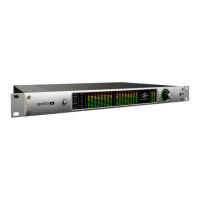Apollo 16 Hardware Manual Troubleshooting 33
Troubleshooting
If Apollo 16 isn’t behaving the way you expect it to, here are some common troubleshooting items to confirm. If
you are still experiencing issues after performing these checks, contact technical support (see “Technical Sup-
port” on page 9).
SYMPTOM ITEMS TO CHECK
Unit won’t power on • Confirm power supply connections at power supply input and back of unit
• Confirm Power switch is not in “OFF” position
• Confirm AC power is available at wall socket by plugging in a different device
No monitor output • Confirm UAD Powered Plug-Ins software is properly installed and configured (page 17)
• Confirm connections, power, and volume of monitoring system
• Confirm monitor knob is turned up
• Confirm monitor outputs are not muted (push monitor knob - green = not muted, red = muted)
• Confirm monitor level meter LEDs are active (check signal flows)
Monitor output level range is
too loud or too quiet
• Monitor output reference levels can be switched between -10 dBV and +4 dBu in the Outputs
panel in the Console Settings window within the Console application
Input levels are too high or too
low
• Input reference levels can be switched between -10 dBV and +4 dBu in the input channel
strips of the Console application
Can’t fine tune input signal
levels
• Signal levels for all inputs, including digital inputs, are adjusted at the device connected to
those inputs
Output levels are too high or
too low
• Output reference levels for adjacent pairs can be switched between -10 dBV and +4 dBu in the
Outputs panel in the Console Settings window within the Console application
Audio glitches and/or dropouts • Increase audio buffer size setting in DAW
• Confirm clocking setups (check cable connections and confirm all device clocks are synchro-
nized to one master clock device)
Undesirable echo/phasing • Confirm input monitoring is not enabled in both Console and DAW
HOST indicator is not lit • Confirm FireWire or Thunderbolt connections
• Confirm Apollo 16 software (UAD Powered Plug-Ins) is installed
• Restart computer and power cycle Apollo 16
• Reinstall Apollo 16 software
• Try a different FireWire or Thunderbolt cable
Faint static and/or white
noise is heard when nothing is
plugged in
• Mute unused inputs
• Some UAD plug-ins model the noise characteristics of the original equipment. Defeat the noise
model in the plug-in GUI or mute the channel containing the plug-in to temporarily mute the
noise
Various LEDs inside the unit are
blinking
• This is normal operational behavior that can be safely ignored
Apollo 16 is behaving unexpectedly • As a last resort, perform a hardware reset on the unit by following these steps:
1. Power off Apollo 16
2. Press and hold the PREAMP, LOW CUT, and POLARITY controls
3. Power on Apollo 16 while continuing to hold all three controls
4. After all front panel LEDs flash rapidly (after several seconds), release the controls

